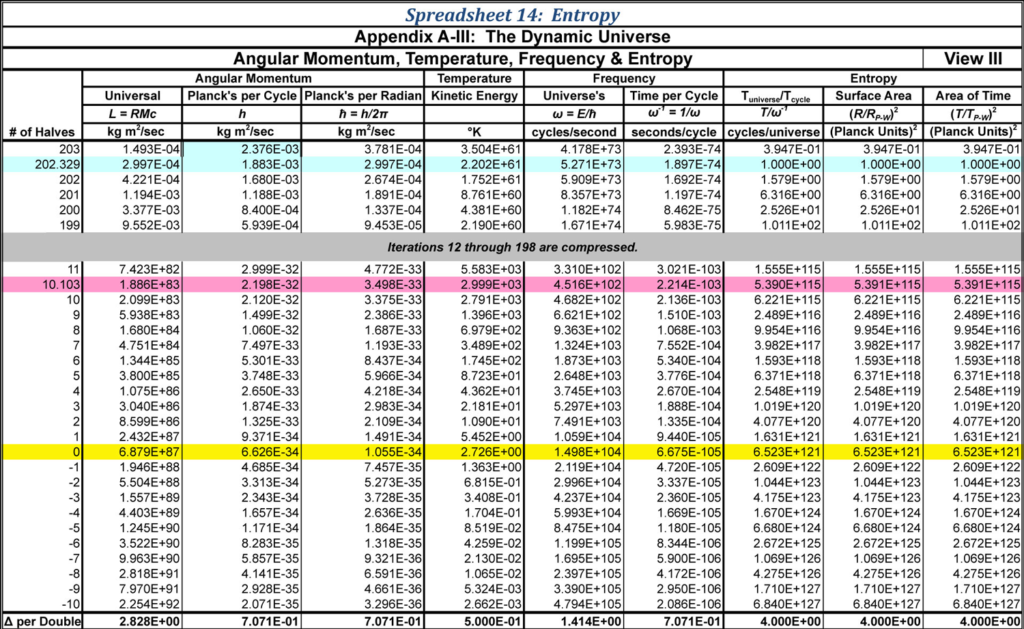Download this chapter for offline viewing (no videos, 2MB)
Download this chapter for offline viewing (includes video content, 79MB)
The waveforms of quantum mechanical processes generate events that are placed in Minkowskian spacetime. These are added to the mass of the Universal Black Hole and the surface of time. From the first event of the Big Bang to the current 10121 accumulated events of today, entropy has steadily increased. It is a product of the Universe’s frequency multiplied by the passage of time. The digital codes generated in this process and the patterns that they form are the structure of information.
The Arrow of Time
Glasses break; water falls; coffee cools; life systems age; iron rusts; sugar in tea disperses; Earth radiates heat; refrigerators heat the room where they are located more than they cool their contents; Sun radiates; the Universe cools; and space expands. These are all familiar examples of the one-way arrow of entropy. Though greater order routinely is created from disorder, such as in the glass factory or within the refrigerator, these processes are local in nature and require an even greater expenditure of energy in the form of work (a corollary of disorder) than the order created. The second law of thermodynamics clearly states that globally systems move to greater disorder.
Entropy is a state variable that examines the global randomness and its changes over time of a mutually-interdependent selected system. It is the quantification of a system’s disorder. Entropy can either stay the same (as in a closed system over an arbitrarily short time period) or increase. It can decrease locally only when acted upon by an outside system through the application of work. But such work increases the entropy elsewhere more than it locally decreases entropy. Globally entropy can never decrease. The drive to increased randomness is so great that its violation would reverse the order of causality making the string of events as absurd as watching a movie backwards. The increase in entropy becomes the direction of causality and hence the “arrow of time”.
The Second Law of Thermodynamics
The second law of thermodynamics states that if within a system there are imbalances, then when the barriers separating these regions of imbalance are reduced, energy will flow from the area of greater heat, or pressure, or concentration to the regions of lower temperature, pressure, and concentration. Processes move toward the state of greatest disorder over time.
A concise definition of the thermodynamics’ second law proves difficult due to its all-encompassing nature. It is usually defined by its manifestations more than by its cause. Historical quotes, as presented in Wikipedia, describe just some of its features.
- In an isolated system, a process can occur only if it increases the total entropy of the system. (Rudolf Clausius)
- Heat cannot spontaneously flow from a material at lower temperature to a material at higher temperature. (Rudolf Clausius)
- It is impossible to convert heat completely into work. (Lord Kelvin)
- The entropy of the Universe tends to a maximum. (Rudolf Clausius)
When the Universe was young, it existed in a single ubiquitous plasma state with only slight variations in the temperature from one region to another. The Universe shared a similar state of entropy throughout. The level of disorder varied little from region to region. The only barrier to the flow of energy from one region to another was distance. Since entropy was evenly distributed throughout, its increase happened as a whole system rather than in localized groups. As the Universe expanded, entropy increased globally with only minimal local isolation.
Eventually, matter cooled sufficiently to become neutral atoms. This vastly decreased localized radiation pressure, enabling matter to group gravitationally into what became the galaxies. As matter grouped, entropy systems, divided by their gravitational containers, became more local. Black holes are the most extreme case of gravitationally isolated systems.
While systems can be grouped by gravity or other physical barriers or just randomly selected for the convenience of the measuring process, all are part of an even greater system known as the Universe. The second law of thermodynamics applies to the entire Universe. The fact that the Universe is a single, inter-dependent thermodynamic system makes our Universe separate from all other possible universes.
Entropy
Entropy is the degree that a system has dispersed. It is a measure of randomness. There are a number of ways to define it. Most of these explain a particular characteristic of entropy rather than defining its nature. Three common ways of defining entropy are: 1) heat entropy, 2) time entropy, and 3) statistical entropy.
- Heat Entropy
The most common way that entropy is expressed is heat entropy. Over any given system heat can be added through the application of work, but that addition means that the heat source must expend more heat than that which is added.
The heat source might be chemical, mechanical, radiative, due to gravitational pressure, or even nuclear. While the work done with the heat might locally reduce the entropy, such as when making a glass jar, the overall system has gained entropy because more energy was expended in the heat production process than the work accomplished.
The only truly isolated system in the cosmos is the whole Universe since everything within is interdependent on everything else. At the Big Bang the Universe began at an extraordinarily high temperature. Since then that temperature has only decreased as the Universe expanded. At the time of the CBR event the Universe was a ubiquitous temperature of 3,000 K. Now that temperature is 2.76 K with local hot spots due to gravity’s concentration process.
An example of the calculation of the entropy for a heat-based system is a formulation used involving Boltzmann’s constant. This formula involves the natural logarithm of the total number of possible microstates (Ω) times Boltzmann’s constant (k):
S = k In Ω
where:
| S | is the total system’s entropy |
| k | is Boltzmann’s constant or 1.38064852 • 10-23 J per degree Kelvin |
| Ω | is the total number of microstates |
Boltzmann’s constant relates to the average kinetic energy of a free gas and thus only applies to this limited description of a defined system.
- Time Entropy
Entropy also can be defined as time entropy. The Universe’s expansion spreads matter and free energy, but gravity locally groups matter. That grouping would seem to reduce disorder by spontaneously organizing matter-based systems. That would appear to mean that entropy decreased without the application of work.
However, this is not the case. The pressure resulting from gravitational consolidation causes an increase in temperature resulting in higher particle random movement and an increase in radiation.
Gravity results in another source of entropy. When in the curved spacetime of a large gravitational source, local time slows relative to distant objects. The Universe disperses mass through the expansion of space. But space represents only three of the four dimensions of spacetime. The slowed time in the presence of a massive object causes local events to be spread out through time. Events in slowed time are dispersed away from the Universe’s center, which is the Big Bang.
Every second of ambient spacetime the Universe expands 300,000 km. If in proximity of a large mass that second is longer than in flat spacetime. Therefore, the distance between events is increased over the normal experience. This spreading out is an increase in entropy.
The Universe ages, and as it does entropy increases just as it does with the increase in space.
- Statistical Entropy
Assume a room is divided in half by a barrier. One half is in a vacuum state with no air particles and the other half is filled with air. When the barrier is removed, in a very short period of time the air particles will disburse into the vacuum and fill the void. Shortly later the air density will be very close to equal throughout the total room.
In theory all of the air particles could gather in a corner of the room, but this would be, for all practical purposes, impossible. Random motion of individual particles cause ubiquitous conditions throughout the whole system.
Statistically, one could flip a coin 50 times and get 50 heads. But 50 heads is only one state of all possible states. Another state would be to have one tail. Unlike all 50 being heads, the tail could be the first flip, or the second or any one of the other 48 flips. In total there would be 50 possible microstates that have one tail compared to only one microstate generating all heads.
The “all heads” scenario has one microstate or a probability of 1 out of the total number of microstates. The number of single tail microstates is 50, i.e., any single one of the 50 coin tosses could be the one tail. The total number of microstates is 250 or 1.125899906842620 quadrillion.
We can replace coin flips with zeros and ones of computer code. 1 could be considered a head while 0 a tail or vice versa. Since each number in the sequence has the same probability of being a zero or a one then the overall number of computer microstates that a 50 digit code offers would be 1.1259 quadrillion as in the heads/tails example.
Statistical entropy is a tendency toward random dispersion, which always has a higher probability than order. Systems move from relative order to greater disorder. This is a statistical certainty.
But in that disorder there are patterns. In those patterns is information, just as in computer code or the alternating combinations of the four amino acids of DNA (adenine, cytosine, guanine, and thymine).
Entropy Redefined
The standard measures of entropy involve the use of natural logarithms. This reduces the expression of the total number of microstates of a system to a manageable number. Here we are going to define entropy as the total number of events. The total number of events is not the total number of microstates, but it is a number that can be quantified. Here we still use S to represent entropy.
The Universe generates events in spacetime. Each event has a specific location and radius when formed. These events occur within the randomness of their quantum waveforms. Each event is guided by its statistical quantum characteristics. Once created, they become part of the Universe’s history.
Events occur within event space. The total number of event space units for a Universe that has a present radius of 1.3054 • 1026 m is a calculation that involves determining the volume of quantum event space that exists for the Universe. Note that this radius is for this particular point in time. Event space is constantly changing and expanding exponentially with the Universe’s growth.
Event space is determined by the Universe’s quantum volume. The Universe doesn’t use meters to partition space. It uses quanta. Space does not expand smoothly. It expands in discrete Planck-Wheeler units. Each Planck-Wheeler unit of time causes the Universal Black Hole’s radius to increase by one Planck-Wheeler unit of space. Therefore, the current radius can be restated as 8.0768 • 1060 RP-W.
While measurement units have been designed and standardized by humanity to conveniently define physical quantities, RP-W is the same throughout the cosmos and has been constant during the Universe’s entire incarnation. RPlanck-Wheeler is the unified unit for length. It can be referred to as a single quantum unit or just q. Therefore the Universe’s present radius can be restated as 8.0768 • 1060 q.

The Universe has doubled in radius 202.32947 times from its Planck-Wheeler radius beginning. The Universe’s quantum radius can also be calculated by taking the doubling factor, i.e., 2 to the 202.32947 power, the number of doubles calculated in the spreadsheets.

This could be referred to as Log2 (8.0768 • 1060) = 202.32947. If expressed as a natural logarithm of e, the quantum radius is LN (8.0768 • 1060) = 140.244.
Accumulated Events of Time
Events are created with every quantum waveform. This occurs when that waveform crosses the central meridian into the zero layer.

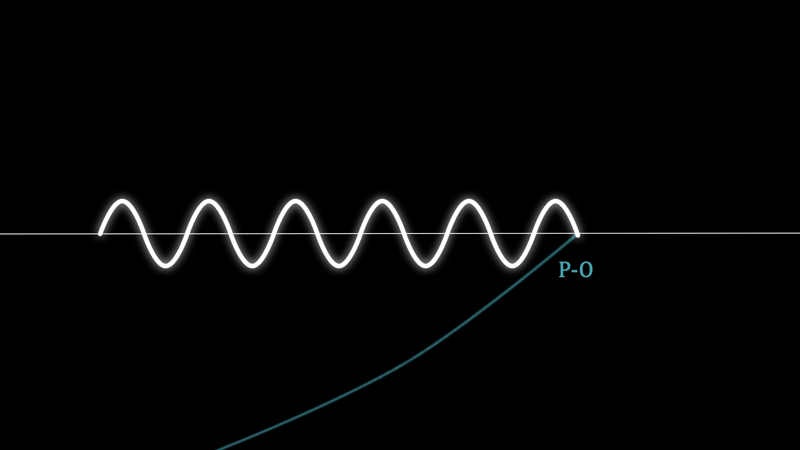
Every wave cycle of matter and energy generates two quanta of Planck-Otto energy. The rate that events are generated is the Universe’s frequency. The Universe has a frequency of event creation that is equal to its total energy content divided by Planck’s angular momentum. As previously calculated at the present this is 1.498135 • 10104 events per second.
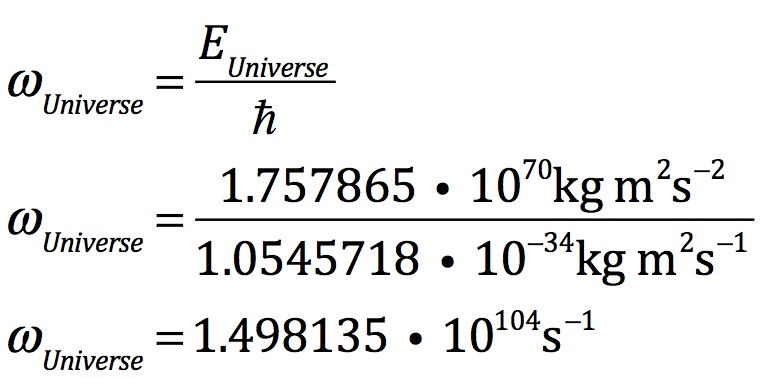
Time accumulates these events and forms the experience of the Universe. The total number of events for the Universal Black Hole is the product of the frequency and the age of the Universe. This is 6.523468 • 10121 events for the current Universe radius.
Entropy = Events Produced
The events generated by the waveform/Planck-Otto radiation process effectively are the entropy of the Universe. Entropy is represented by the symbol S. Where entropy for a large system is essentially incalculable, for the Universe as a whole it is an absolute for each present Universal Black Hole radius. It is calculated as follows for the current radius of the Universal Black Hole:

Note that entropy is being defined as the total number of events to ever have occurred in the Universe’s history. This is not the classical way of determining entropy, but it actually is a more effective method.
Surface Area of Time
Events increase the mass of the Universe one quantum at a time. This growth of mass increases the radius of the Universal Black Hole. Therefore, events are generated as the Universe expands, and the Universe expands as events are generated. The vantage point for time is the current surface area of the Universal Black Hole. This surface area is equal to R2. Every quantum generated by these events are represented on the surface of time of the black hole. Each event increases the surface area by a postage stamp-like square equal to one Planck-Wheeler radius on each side:


If the surface of the Universal Black Hole is divided into individual Planck-Wheeler quantum squares their summation equals the Universe’s entropy:
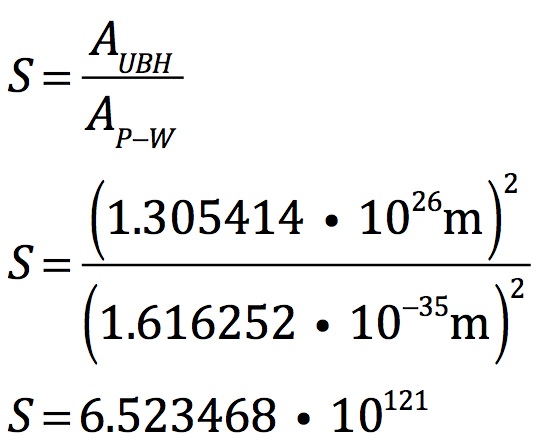
The same result can be calculated by dividing the square of the Universe’s age by the square of Planck-Wheeler’s time:
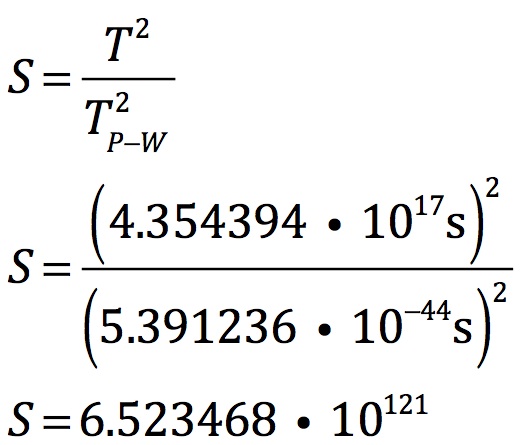
Time is a surface phenomenon. Kepler’s third law of planetary motion relates the square of the period (area of time) of an orbit to the cube of the radius of the orbit (volume of space). The Universe ages in the same way. The surface area of the Universal Black Hole divided by Planck area units is the age of the Universe. This surface area is the event horizon of the Universal Black Hole.
Event horizon is the most appropriate name for this spacetime margin. The events of the Universe’s existence are counted. Their number has a physical reality. That reality is the surface area of the Universe’s black hole divided into quantum areas.
The mass of the Universe leads to its Schwarzschild radius. That radius leads to an event horizon that is the surface area of time. That surface area has a quantum content equal to the number of Planck units residing there. Each Planck unit represents an event that is marked by a recorded quantum. Each quantum when formed emitted a Planck-Otto unit of mass, the summation of which yields the Schwarzschild radius of the Universe. In this way information equals mass.
Information Content
The event horizon surface of time is the summation of all the events ever generated by the Universe. These are the number of events, but by themselves they do not contain any information. If a coder using zeros and ones gives a series of ones only, no information has been generated. A series of 111111111111111111111111111111111111111 contains no information other than existence.
If a black hole is perceived from the outside, its surface contains no information. It is just one unit of space. Its size is a product of how much quantum information from the host universe went into forming that black hole. That information is the historical record of how that black hole was formed in the first place. But the surface area tells nothing of the separate universe within.
In this way our Universe shows nothing of its internal experience to the progenitor universe that formed our home. All that is seen is the standing waveform of quanta that the event horizon surface area represents. Our Universe appears as just a series of ones from this vantage point.
The universe within, i.e., our Universe, has a totally different vantage point. Inside the Universal Black Hole another dimension is added. That is time. All of the events that made up the Universe formed within a three-dimensional unit of space when the Universe was at a specific age embodied in its instantaneous radius. The distance between these events are the missing zeros of information code. Within the Universe what appears to be informationless from the outside becomes the entire recorded history of the Universe’s experience.
The events are the ones and the space between become the zeros. The positioning of these, the form that they take, and the order which they were formed creates the content of that information. That form may be embedded in the structure of matter, since matter retains the events that formed it, or it may be in the ethereal form of a concept. Nevertheless, that information is retained. Patterns become the nature of information.
Entropy
Since the radius of the Universe is 8.0768 • 1060 q, then the total volume of space converted into quanta cubes is:
Rq3 = or 5.268875 • 10182q3.
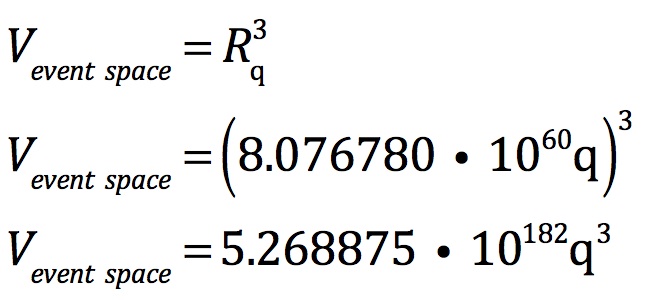
This is the total number of event space units. In terms of zeros and ones, any one of these event space units could be where an event was formed. In digital terms, any one of the points could be a one. The space in between would be a digital zero. In reality, very few of these points are occupied by an event. Only 6.523468 • 10121 are so occupied. An event either occurs in a particular event space or it doesn’t. There are massively fewer events than event space. Occam’s Razor tells us how many that there are.
Visible light has wavelengths in the vicinity of 400 nm or 4 • 10-7 m. This means that the average quantum distance between wave nodes, or for this discussion digital ones, is 1028 q since that is the quantum equivalent of visible light’s wavelength.

This means that there are 1.24 • 1028 zeros between every light event. This is just the linear direction in which the light wave travels. There are massive numbers of quantum zero space in the other two Cartesian dimensions. This spacing means that there are dimensions to the patterns generated by waveforms. In these patterns is information.
The Universe is not half heads and half tails. The incredible amount of zero space in proportion to event-selected space means that the total number of microstates is not

units of event space as in the head/tail sample. If it is a given that the number of heads is guaranteed to be ten out of the total fifty tosses, then the number of microstates possible is drastically reduced. In the case of the Universe, we choose to leave undefined the total number of microstates established by the Universe’s radius. We define entropy by its event content and not the quantum distance between events. The entropy of 6.523468 • 10121 events are specifically defined at this present radius.
Entropy at the CBR Event

Searching for the Big Bang
If we reverse time all the way back the Big Bang, we are able to calculate the entropy of the newly formed Universe. When we multiply the previously calculated Universe frequency by the Universe’s age at the Big Bang, the result is the entropy for the Universe. At the Big Bang the entropy was equal to one.

Entropy of one equals the total experience of the Universal Black Hole at the Big Bang. The Big Bang is the first event of the Universe; therefore, the entropy was unitary.
All of this Universe’s extraordinary complexity derived from the seed DNA of this initial event. It is seen here that if we take the physics of our present Universe and follow it backwards to the Big Bang, we find that origin event, and it has the entropy of ONE.
